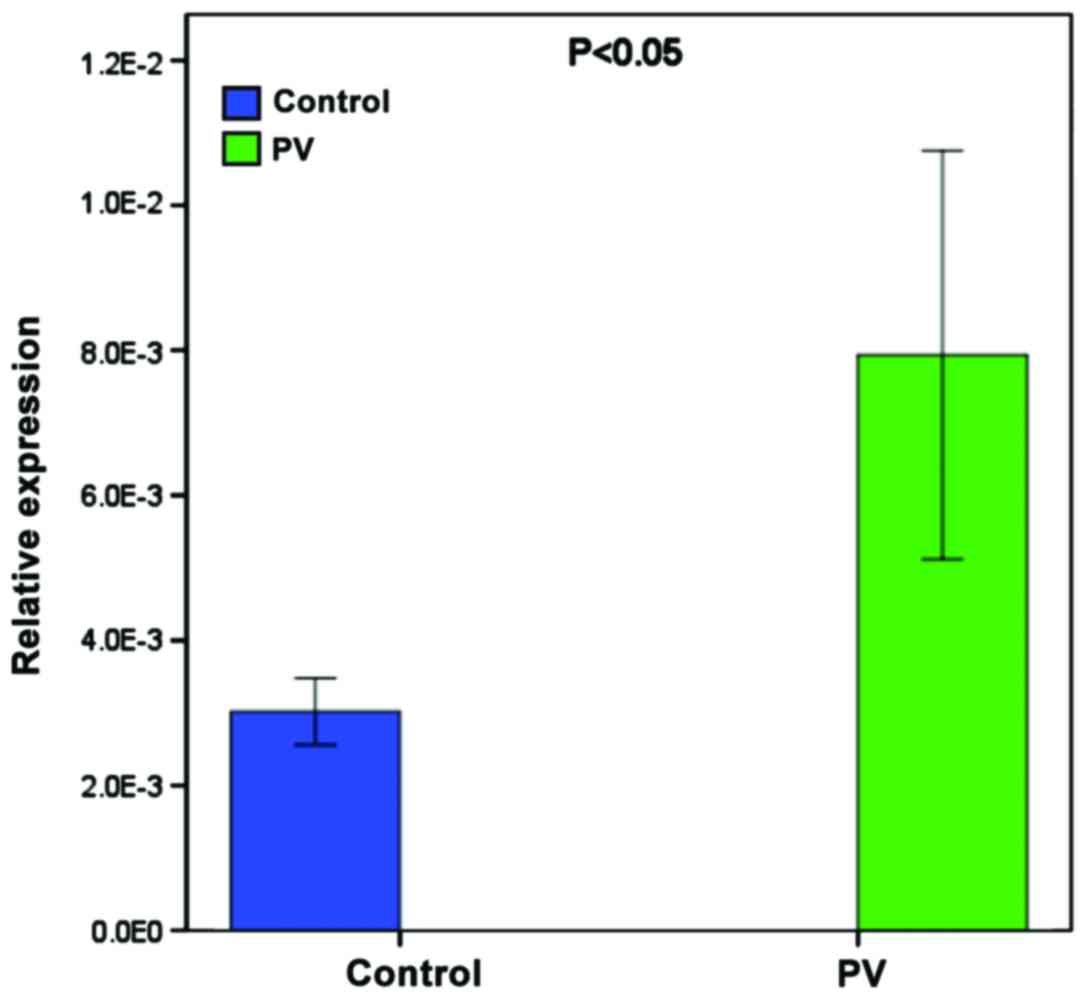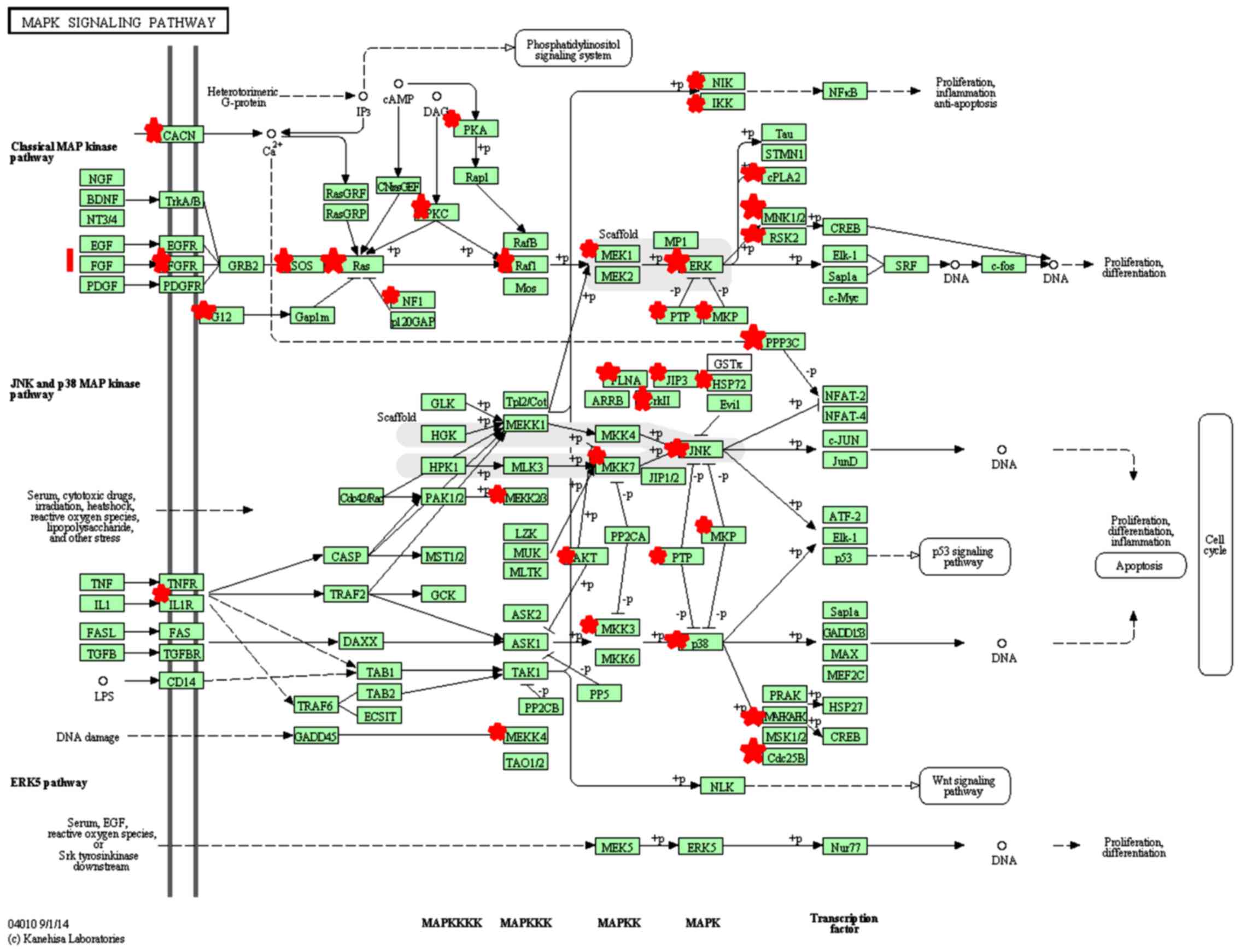|
1
|
Rizzo C, Fotino M, Zhang Y, Chow S,
Spizuoco A and Sinha AA: Direct characterization of human T cells
in pemphigus vulgaris reveals elevated autoantigen-specific Th2
activity in association with active disease. Clin Exp Dermatol.
30:535–540. 2005. View Article : Google Scholar : PubMed/NCBI
|
|
2
|
Sugiyama H, Matsue H, Nagasaka A, Nakamura
Y, Tsukamoto K, Shibagaki N, Kawamura T, Kitamura R, Ando N and
Shimada S: CD4+CD25high regulatory T cells
are markedly decreased in blood of patients with pemphigus
vulgaris. Dermatology. 214:210–220. 2007. View Article : Google Scholar : PubMed/NCBI
|
|
3
|
von Bubnoff D, Andrès E, Hentges F, Bieber
T, Michel T and Zimmer J: Natural killer cells in atopic and
autoimmune diseases of the skin. J Allergy Clin Immunol. 125:60–68.
2010. View Article : Google Scholar : PubMed/NCBI
|
|
4
|
Xu RC, Zhu HQ, Li WP, Zhao XQ, Yuan HJ,
Zheng J and Pan M: The imbalance of Th17 and regulatory T cells in
pemphigus patients. Eur J Dermatol. 23:795–802. 2013.PubMed/NCBI
|
|
5
|
Ambros V: The functions of animal
microRNAs. Nature. 431:350–355. 2004. View Article : Google Scholar : PubMed/NCBI
|
|
6
|
Pasquinelli AE, Reinhart BJ, Slack F,
Martindale MQ, Kuroda MI, Maller B, Hayward DC, Ball EE, Degnan B,
Müller P, et al: Conservation of the sequence and temporal
expression of let-7 heterochronic regulatory RNA. Nature.
408:86–89. 2000. View
Article : Google Scholar : PubMed/NCBI
|
|
7
|
Chen CZ: MicroRNAs as oncogenes and tumor
suppressors. N Engl J Med. 353:1768–1771. 2005. View Article : Google Scholar : PubMed/NCBI
|
|
8
|
Xiao C and Rajewsky K: MicroRNA control in
the immune system: basic principles. Cell. 136:26–36. 2009.
View Article : Google Scholar : PubMed/NCBI
|
|
9
|
Simpson LJ and Ansel KM: MicroRNA
regulation of lymphocyte tolerance and autoimmunity. J Clin Invest.
125:2242–2249. 2015. View
Article : Google Scholar : PubMed/NCBI
|
|
10
|
Heegaard NH, Carlsen AL, Skovgaard K and
Heegaard PM: Circulating extracellular microRNA in systemic
autoimmunity. EXS. 106:171–195. 2015.PubMed/NCBI
|
|
11
|
Amagai M, Tanikawa A, Shimizu T, Hashimoto
T, Ikeda S, Kurosawa M, Niizeki H, Aoyama Y, Iwatsuki K and
Kitajima Y: Committee for Guidelines for the Management of
Pemphigus Disease: Japanese guidelines for the management of
pemphigus. J Dermatol. 41:471–486. 2014. View Article : Google Scholar : PubMed/NCBI
|
|
12
|
Noble WS: How does multiple testing
correction work? Nat Biotechnol. 27:1135–1137. 2009. View Article : Google Scholar : PubMed/NCBI
|
|
13
|
Grassmann F, Schoenberger PG, Brandl C,
Schick T, Hasler D, Meister G, Fleckenstein M, Lindner M, Helbig H,
Fauser S, et al: A circulating microRNA profile is associated with
late-stage neovascular age-related macular degeneration. PLoS One.
9:e1074612014. View Article : Google Scholar : PubMed/NCBI
|
|
14
|
Braza-Boïls A, Salloum-Asfar S,
Marí-Alexandre J, Arroyo AB, González-Conejero R, Barceló-Molina M,
García-Oms J, Vicente V, Estellés A, Gilabert-Estellés J, et al:
Peritoneal fluid modifies the microRNA expression profile in
endometrial and endometriotic cells from women with endometriosis.
Hum Reprod. 30:2292–2302. 2015. View Article : Google Scholar : PubMed/NCBI
|
|
15
|
Wu K, Hu G, He X, Zhou P, Li J, He B and
Sun W: MicroRNA-424-5p suppresses the expression of SOCS6 in
pancreatic cancer. Pathol Oncol Res. 19:739–748. 2013. View Article : Google Scholar : PubMed/NCBI
|
|
16
|
Zhang Y, Li T, Guo P, Kang J, Wei Q, Jia
X, Zhao W, Huai W, Qiu Y, Sun L, et al: miR-424-5p reversed
epithelial-mesenchymal transition of anchorage-independent HCC
cells by directly targeting ICAT and suppressed HCC progression.
Sci Rep. 4:62482014. View Article : Google Scholar : PubMed/NCBI
|
|
17
|
Meng QL, Liu F, Yang XY, Liu XM, Zhang X,
Zhang C and Zhang ZD: Identification of latent tuberculosis
infection-related microRNAs in human U937 macrophages expressing
Mycobacterium tuberculosis Hsp16.3. BMC Microbiol. 14:372014.
View Article : Google Scholar : PubMed/NCBI
|
|
18
|
Jinnin M: Recent progress in studies of
miRNA and skin diseases. J Dermatol. 42:551–558. 2015. View Article : Google Scholar : PubMed/NCBI
|
|
19
|
Forrest AR, Kanamori-Katayama M, Tomaru Y,
Lassmann T, Ninomiya N, Takahashi Y, de Hoon MJ, Kubosaki A, Kaiho
A, Suzuki M, et al: Induction of microRNAs, mir-155, mir-222,
mir-424 and mir-503, promotes monocytic differentiation through
combinatorial regulation. Leukemia. 24:460–466. 2010. View Article : Google Scholar : PubMed/NCBI
|
|
20
|
Li X, Ishii N, Ohata C, Furumura M and
Hashimoto T: Signalling pathways in pemphigus vulgaris. Exp
Dermatol. 23:155–156. 2014. View Article : Google Scholar : PubMed/NCBI
|
|
21
|
Coulthard LR, White DE, Jones DL,
McDermott MF and Burchill SA: p38(MAPK): stress responses from
molecular mechanisms to therapeutics. Trends Mol Med. 15:369–379.
2009. View Article : Google Scholar : PubMed/NCBI
|
|
22
|
Chernyavsky AI, Arredondo J, Kitajima Y,
Sato-Nagai M and Grando SA: Desmoglein versus non-desmoglein
signaling in pemphigus acantholysis: characterization of novel
signaling pathways downstream of pemphigus vulgaris antigens. J
Biol Chem. 282:13804–13812. 2007. View Article : Google Scholar : PubMed/NCBI
|
|
23
|
Berkowitz P, Hu P, Liu Z, Diaz LA, Enghild
JJ, Chua MP and Rubenstein DS: Desmosome signaling. Inhibition of
p38MAPK prevents pemphigus vulgaris IgG-induced cytoskeleton
reorganization. J Biol Chem. 280:23778–23784. 2005. View Article : Google Scholar : PubMed/NCBI
|
|
24
|
Lee HE, Berkowitz P, Jolly PS, Diaz LA,
Chua MP and Rubenstein DS: Biphasic activation of p38MAPK suggests
that apoptosis is a downstream event in pemphigus acantholysis. J
Biol Chem. 284:12524–12532. 2009. View Article : Google Scholar : PubMed/NCBI
|
|
25
|
Berkowitz P, Hu P, Warren S, Liu Z, Diaz
LA and Rubenstein DS: p38MAPK inhibition prevents disease in
pemphigus vulgaris mice. Proc Natl Acad Sci USA. 103:pp.
12855–12860. 2006; View Article : Google Scholar : PubMed/NCBI
|
|
26
|
Berkowitz P, Diaz LA, Hall RP and
Rubenstein DS: Induction of p38MAPK and HSP27 phosphorylation in
pemphigus patient skin. J Invest Dermatol. 128:738–740. 2008.
View Article : Google Scholar : PubMed/NCBI
|
|
27
|
Meunier I, Lenaers G, Bocquet B, Baudoin
C, Piro-Megy C, Cubizolle A, Quilès M, Jean-Charles A, Cohen SY,
Merle H, et al: A dominant mutation in MAPKAPK3, an actor of p38
signaling pathway, causes a new retinal dystrophy involving Bruch's
membrane and retinal pigment epithelium. Hum Mol Genet. 25:916–926.
2016. View Article : Google Scholar : PubMed/NCBI
|
|
28
|
Lemaire M, Ducommun B and Nebreda AR:
UV-induced downregulation of the CDC25B protein in human cells.
FEBS Lett. 584:1199–1204. 2010. View Article : Google Scholar : PubMed/NCBI
|
|
29
|
Lemaire M, Froment C, Boutros R, Mondesert
O, Nebreda AR, Monsarrat B and Ducommun B: CDC25B phosphorylation
by p38 and MK-2. Cell Cycle. 5:1649–1653. 2006. View Article : Google Scholar : PubMed/NCBI
|
|
30
|
Song GQ and Zhao Y: MicroRNA-211, a direct
negative regulator of CDC25B expression, inhibits triple-negative
breast cancer cells' growth and migration. Tumour Biol.
36:5001–5009. 2015. View Article : Google Scholar : PubMed/NCBI
|
|
31
|
Kar S, Wang M, Ham SW and Carr BI:
Fluorinated Cpd 5, a pure arylating K-vitamin derivative, inhibits
human hepatoma cell growth by inhibiting Cdc25 and activating MAPK.
Biochem Pharmacol. 72:1217–1227. 2006. View Article : Google Scholar : PubMed/NCBI
|
|
32
|
Wang M, Zhu XY, Wang L and Lin Y:
Expression and signi-ficance of CDC25B, PED/PEA-15 in esophageal
carcinoma. Cancer Biother Radiopharm. 30:139–145. 2015. View Article : Google Scholar : PubMed/NCBI
|













